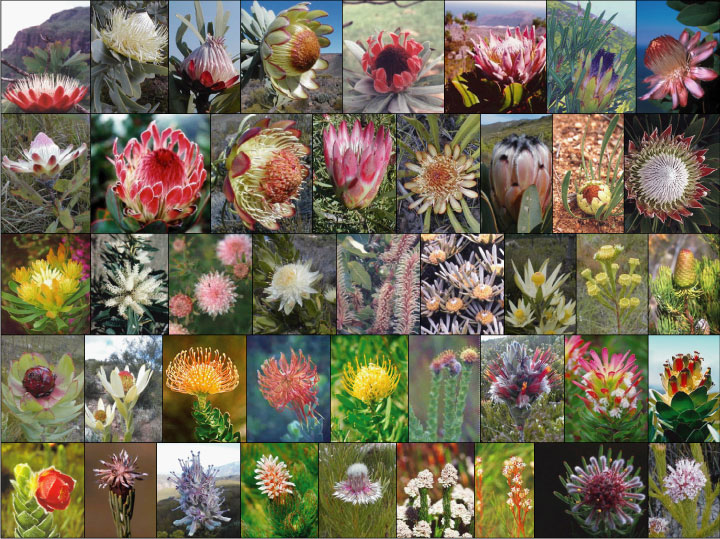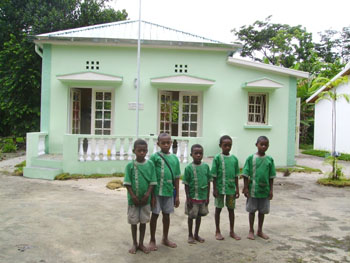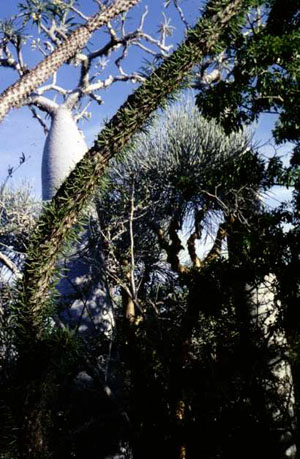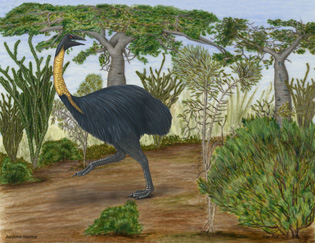
John A. Silander, Jr., Professor (Ph.D.,
 |
 Examples of proteas from the Cape Floristic Region of South Africa |
Contact Information:
Dr. John A. Silander, Jr.
Department of Ecology and
Evolutionary Biology
Tel: (860) 486-2168
Fax: (860) 486-6364
E-Mail: john.silander@uconn.edu
Plant ecology and evolution: biogeography and spatial processes in ecology; landscape ecology; conservation biology; biology of invasive species; experimental plant population and community ecology; population dynamics and competition; forest community ecology of temperate and tropical regions.
Selected Publications:
Pacala, S. W., C. D. Canham, J. Saponara, J. A. Silander, Jr., R. E. Kobe, and E. Ribbens. 1996. Forest models defined by field measurements. II. Estimation, error analysis, and dynamics. Ecological Monographs 66(1): 1-43 [George Mercer Award paper (ESA) 1996] [pdf file]
Mickelson, J. G., Jr., D. L. Circo, and J. A. Silander, Jr. 1998. Delineating forest canopy species in the northeastern
Silander, J. A., Jr. and D. M. Klepeis. 1999. The invasion ecology of Japanese barberry (Berberis thunbergii) in the
Silander, J. A., Jr. 2000. Temperate forests: plant species biodiversity and conservation. In (
Agarwal, D. K., A. E. Gelfand and J. A. Silander, Jr. 2002. Investigating tropical deforestation using two state spatially misaligned regression models. Journal of Agricultural, Biological and Environmental Statistics. 7(3):420-439 [American Statistical Society Award paper for 2000]. [pdf file]
Gelfand, A.E., A.M. Schmidt, S. Wu, J. A. Silander, Jr., A. M. Latimer and A.G. Rebelo. 2005. Modelling species diversity through species level hierarchical modeling. Journal of the Royal Statistical Society, Section C Applied Statistics 54(1):1-20 [pdf file]
Agarwal, D. K., J. A. Silander, Jr., A.E. Gelfand, R.E. Dewar, and J.G. Mickelson, Jr. 2005. Tropical Deforestation in
Gelfand, A. E., J. A. Silander, Jr., S. Wu, A. M. Latimer, P. Lewis, Anthony G. Rebelo and M. Holder. 2005. Explaining species distribution patterns through hierarchical modeling. Bayesian Analysis 1:42-92. (pdf file ) (with supplement).
Latimer, A.M., J.A. Silander, Jr. and R.M Cowling. 2005. Neutral theory reveals isolation and rapid speciation in a biodiversity hotspot. Science 309:1722-1725 (pdf file ) (plus appendices).
Latimer, A. M., S. Wu, A. E. Gelfand and J. A. Silander, Jr. 2006. Building statistical models to analyze species distributions. Ecological Applications 16(1): 33-50 (pdf file ) plus Appendices: Ecological Archives: A016-003-A1 and A016-003-S1.
Leicht, S. A. and J. A. Silander Jr. 2006. Differential Responses of Invasive Celastrus orbiculatus (Celastraceae) and Native C. scandens to Changes in Light Quality. American Journal of Botany 93(7): 972-977 (pdf file ).
Bond, W. and J. A. Silander Jr., Jr. 2007. Springs and wire plants: anachronistic defenses against
Barber, J.J., A.E. Gelfand and J.A. Silander Jr.. 2006. Modeling map position error to infer about true feature location. Canadian Journal of Statistics. 34(4): 1–18. (pdf file)
Leicht-Young, S.A. , J. A. Silander Jr. and A. M. Latimer. 2007. Comparative performance of invasive and native Celastrus species in heterogeneous environments. Oecologia 154(2):273-282. (pdf file)
de Gouvenain, R. C., R. K. Kobe, and J. A. Silander, Jr. 2007. Partitioning of understory light and dry-season soil moisture gradients among seedlings of four rain-forest tree species in Madagascar. Journal of Tropical Ecology 23(5): 569-579. (pdf file)
Bond, W., J. A. Silander, Jr., J. Ranaivonasy and J. Ratsirarson 2008. The antiquity of Madagascar’s grasslands and the rise of C4 grassy biomes. Journal of Biogeography 35(10): 1743-1748 (with editorial commentary on the article). (pdf file)
Ibáñez, I., J. A. Silander Jr., A. M. Wilson, N. LaFleur, N. Tanaka and Ikutaro Tsuyama. 2009. Multi-variate forecasts of potential distributions of invasive plant species. Ecological Applications 19(2): 359–375. (pdf file)
Mosher, E.S., J.A. Silander, Jr. and A.M. Latimer 2009. The role of land-use history in major invasions by woody plant species in the northeastern North American Landscape. Biological Invasions 11(10): 2317-2328. (pdf file)
Latimer, A.M., S. Banerjee, H. Sang, E. S. Mosher and J. A. Silander, Jr. 2009. Hierarchical models facilitate spatial analysis of large data sets: a case study on invasive plant species in the northeastern United States. Ecology Letters 12: 144–154. (pdf file)
Leicht-Young, S.A., H. O’Donnell, A.M. Latimer and J.A. Silander, Jr. 2009. Effects of an invasive plant species, Celastrus orbiculatus, on soil composition and processes. American Midland Naturalist 161: 219-231. (pdf file)
Latimer, A.M., J.A. Silander, Jr. A.G. Rebelo and G.F. Midgley. 2009. Experimental biogeography: the role of environmental gradients in high geographic diversity in Cape Proteaceae. Oecologia 160:151–162. (pdf file)
Primack, R.B., I. Ibáñez, H. Higuchi, S.D. Lee, A.J. Miller-Rushing, A. Wilson and J.A. Silander, Jr. 2009. Spatio-temporal mismatches in species responses to climate change. Biological Conservation 142: 2569–2577. (pdf file)
Ibáñez, I., J.A. Silander Jr., J.M. Allen, S.A. Treanor, and A.M. Wilson. 2009. Identifying hotspots for plant invasions and forecasting focal points of further spread. Journal of Applied Ecology 46, 1219–1228. (pdf file)
Wilson, A.M. A.M Latimer, J.A. Silander, Jr., A.E. Gelfand and H. de Klerk. 2010. A Hierarchical Bayesian model of wildfire in a Mediterranean biodiversity hotspot: implications of weather variability and global circulation. Ecological Modelling 221(1): 106-112. (pdf file)
Ferketic, J.S., A.M. Latimer, and J.A. Silander Jr. 2010. Conservation justice in metropolitan Cape Town: A study at the Macassar Dunes Conservation Area. Biological Conservation. 143(5): 1168-1174. (pdf file)
Ibáñez, I., R. B. Primack, A. J. Miller-Rushing, E. Ellwood, H. Higuchi, S.D. Lee, H. Kobori, and J. A. Silander, Jr. 2010. Forecasting phenology under global warming. Philosophical Transactions of the Royal Society (B): Biological Sciences 365: 3247-3260. (pdf file)
Wilson A.M., J.A. Silander, Jr., A E. Gelfand and J. H. Glenn. 2011. Scaling up: linking field data and remote sensing with a hierarchical model (Special Issue paper: Spatial Ecology). International Journal of Geographical Information Science 25(3): 509-521. (pdf file)
Chakraborty, A., A. E. Gelfand, A. M. Wilson, A. M. Latimer and J. A. Silander, Jr. 2010. Modeling large scale species abundance with latent spatial processes. Annals of Applied Statistics 4(3): 1403–1429. (pdf file)
Merow, C., A. M. Latimer, And J.A. Silander, Jr. 2011. Can Entropy Maximization Use Functional Traits To Explain Species Abundances? A Comprehensive Evaluation. Ecology 92(7): 1523-1537. (pdf file)
Merow, C, N. LaFleur, J.A. Silander, Jr. A.M. Wilson and M. Rubega. 2011. Developing dynamic, mechanistic species distribution models: predicting bird-mediated spread of invasive plants across northeastern North America. American Naturalist 178(1): 30-43. (pdf file)
Stacey A. Leicht-Young, S.A., A. M. Latimer., and J.A. Silander, Jr. 2011. Lianas escape self-thinning: experimental evidence of positive density dependence in temperate lianas Celastrus orbiculatus and C. scandens. Perspectives in Plant Ecology, Evolution and Systematics 13(3):163-172. (pdf file)
Chakraborty, A., A. E. Gelfand, A. M. Wilson, A. M. Latimer and J. A. Silander, Jr. 2011. Point Pattern Modeling for Degraded Presence-Only Data over Large Regions. Journal of the Royal Statistical Society, Section C Applied Statistics 60(5): 757-776. (pdf file)
Bois, S.T., J.A. Silander Jr., and L. J. Mehrhoff. 2011. Invasive Plant Atlas of New England, the Role of Citizens in the Science of Invasive Alien Species Detection. BioScience 61(10):763-770. (pdf file)
Ellwood, E.R., J. M. Diez, I. Ibáñez, R. B. Primack, H. Kobori, H..Higuchi, J. A. Silander, Jr. 2012. Disentangling the paradox of insect phenology: are temporal trends reflecting the response to warming? Oecologia 168(4): 1161-1171. (pdf file)
Ahmed, K.F., G. Wang, J. A. Silander, Jr., A.M. Wilson, J.M. Allen, R. Horton, and Richard Anyah. 2013. Statistical downscaling and bias correction of climate model outputs for climate change impact assessment in the U.S. Northeast. Global and Planetary Change. 100: 320-332. (pdf file)
Courses Taught: Methods of Ecology, Field Ecology, Seminars in plant ecology and spatial statistics.
Current Research Projects:
1. The Biogeography, Biodiversity and Climate Change in Southern Africa.
This project is multidisciplinary, combining ecology, evolution, genetics, biogeography, climate change and statistics, supported by successive NSF grants. The first objective of the project was to explain biogeographic patterns of plant species distributions and biodiversity in the Cape Floristic Region of South Africa. The “Cape” is biotically one of the most diverse regions in the world, as diverse as many of the world's rainforests. The focal plant group for this study was initially the Proteacea, the iconic plant family of South Africa. We developed novel, spatially explicit statistical models (Hierarchical Bayesian) to understand and predict patterns in species distributions and biodiversity. The data sources include GIS (environmental) data layers, species attribute data, species inventories (from the Protea Atlas Project), phylogenetic information, and other data sources. Extensive field work including experimental biogeography and population genetic analyses was conducted in South Africa. Selected recent papers and manuscripts are listed above. Continued NSF funding has allowed us to explore climate change in Southern Africa and the predicted population and species levels responses of proteas to past and future projected climate change. We also developed models predicting wildfires, biomass change, and ecosystem resilience over time. A related NSF project focuses on evolutionary processes in Protea species. An NSF-IRES grant provided research training support for undergraduate and graduate students studying the ecology and evolutionary biology of the Cape Floristic Region. Most recently, an NSF Dimensions of Biodiversity grant has allowed us to expand our study of biodiversity in the Cape Florist Region to focus on phylogeography, and the genetic and evolutionary basis of plant functional trait variation in two diverse plant genera in the Cape: Protea and Pelargonium. In addition, we are looking at the spatial and temporal dynamics of the plant communities in which these genera occur. Finally, we are developing mechanistically based, predictive range models of proteas, based on integral projection models that will allow us to forecast how species ranges may change over time as climate changes.

Examples of the Proteaceae of the Cape Floristic Region [images are from: T. Rebelo. 2001. Proteas: A Field Guide to the Proteas of Southern Africa, Fernwood press, the Protea Atlas Project, and other sources.] |

The Plant Biogeographic Regions of the World, showing the Cape Floristic Region (bottom, center) |

|
|

Fynbos: the dominant biome type in the CFR -- a Mediterranean climate shrubland. [images from: R. Cowling and D. Richardson. 1995. Fynbos. Fernwood Press, and other sources.] |

The Cape Floristic Region [image from: R. Cowling and D. Richardson. 1995. Fynbos. Fernwood Press.] |
|
A major invasive threat to Celastrus orbiculatus 
|
2. The Ecology of Invasive Plant Species in New England.
This project has focused on developing an on-line atlas and interactive database for invasive plant species and noxious weeds of New England. We are collecting both historical (herbarium) and current field records of species occurrences. With this information we have developed models to predict current and future patterns of invasive species distributions. An integral part of the project is developing an early-detection/early-warning system for new incursions of invasives in the landscape. We are also focusing ecological studies on selected problematic species, including the comparative ecology of native and invasive oriental bittersweet (Celastrus orbiculatus) and Japanese barberry (Berberis thunbergii) species in New England. Another project has focused on the effects of land-use history on susceptibility to biological invasions, and how land-use and land-use change are driven by socio-economic drivers. This project was funded by the USDA. Our IPANE Invasives web site is constantly being updated, and we have recently developed a collaborative relationship with EDDMapS.org to serve our data. We have developed predictive models of invasive species distributions using data from both their native ranges (focus on East Asian species) and where they have been introduced to the US and elsewhere. In addition, we have developed mechanistic, spatially explicit grid-based models of the joint spread of invasive plants and the bird species that disperse them.
3. Phenological Responses of East Asian species to Climate Change. This is a collaborative project funded by NSF that involves researches from UConn, Boston U, U Michigan, plus colleague s from Japan, South Korea and China. The focus is on how species of plants and animals and the communities they occur in have responded phenologically to climate change in the past and how they are forecast to respond in the future. We have used long-term phenological observations in Japan, South Korea and China, paired with meteorological stations, and we have also collaborated with the Japanese Center for Climate System Research for Regional Climate Model projections for the region for the future. Our group has focused on building mechanistic Hierarchical Bayesian models to predictive responses of flowering cherries to past and future climate change. We are also building HB landscape models of forest community responses to past and future climate change comparing responses in New England and East Asia.
4. Sustainable Conservation in Madagascar.
Prior funding from the MacArthur Foundation and NSF focused on understanding and explaining deforestation patterns over time in the eastern coastal rainforests of Madagascar. This project was multidisciplinary involving ecologists, anthropologists, archeologists, geographers, demographers and rural sociologists. Collaborators on this project included former student Dr. Joelisoa Ratsirarson. An experimental component of this project, done in collaboration with former student and post-doctoral fellow, Dr. Roland de Gouvenain, focused on understanding and predicting forest dynamics and regeneration of native tree species. A May 2006 expedition to Madagascar focused on the status and evolution of grassland and savanna systems. Grasslands and conservation of their biota have been largely ignored in Madagascar. We also initiated a study on the coevolutionary history of giant elephant birds and the vegetation they browsed in the thicket biome of southwestern Madagascar (see paper published in the PRS, and highlighted in Current Biology). On-going research focuses on the biology and evolution of the enigmatic elephant birds of Madagascar. A recent, collaborative grant from the MacArthur Foundation (UConn, U Antananarivo and U Cape Town) focuses on training the next generation of researchers in Madagascar on Sustainable Biodiversity, Conservation, and Climate Change Science and Policy.
Current Graduate Student Advisees:




